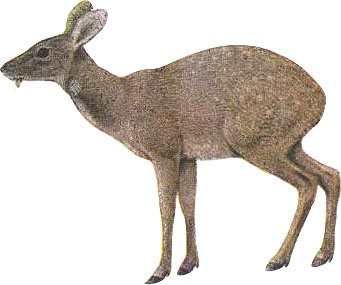Musk
Deer Moschus moschiferous
A
little creature not more than 50 cm high at the shoulder, slightly
higher at the croup. The musk deer hold a place between the
deer and the antelopes. It is regarded as an undeveloped form
of deer, which has not progressed, with rest of his family.
Its horn less and has no face glands. It has a gall bladder
which no deer possess. In some way it has taken a special line
of development of its own.

The musk gland is situated beneath the skin of the abdomen of
the mail when fresh its secretion has a un pleasant, pungent
urinary odour. When dry it acquires the scent of Musk. Valued
as a commercial product. It induces the persecution of the species.
Musk deer wear a coat of thick and bristly hairs all most pithy
in structure. The general color is a shade of rich dark brown
specked with grey.
These live singly or in pairs and are generally met within birch
forest above the zones of pines. At times they come down to
lower levels but always keep in thick cover. The food consists
of grasses, lichens, leaves and flowers. The breeding season
is believed to be in January. And young ones are born in June.
Musk deer ranges over a wide area in central and Northeastern
Asia. The typical form Moschus moschiferous is found in Kashmir,
Nepal and Sikkim.
Return
to Top
|


